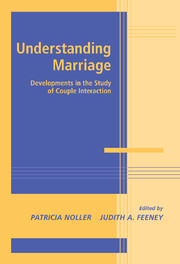Book contents
- Frontmatter
- Contents
- Contribitors
- Introduction
- SECTION ONE THE EFFECT OF COGNITION ON INTERACTION PATTERNS
- SECTION TWO UNDERSTANDING THE IMPORTANCE OF POSITIVE INTERACTION
- SECTION THREE COPING WITH DISAPPOINTMENT, CRITICISM, AND BETRAYAL
- SECTION FOUR POWER, CONFLICT, AND VIOLENCE IN MARITAL INTERACTION
- Marital interaction at important transition periods
- SECTION SIX Interventions for strengthening relationships
- Introduction to Section Six
- 17 Risk Factors, Risk Processes, and the Longitudinal Course of Newlywed Marriage
- 18 Does Working at a Relationship Work? Relationship Self-Regulation and Relationship Outcomes
- Conclusions
- Index
- References
17 - Risk Factors, Risk Processes, and the Longitudinal Course of Newlywed Marriage
Published online by Cambridge University Press: 25 July 2009
- Frontmatter
- Contents
- Contribitors
- Introduction
- SECTION ONE THE EFFECT OF COGNITION ON INTERACTION PATTERNS
- SECTION TWO UNDERSTANDING THE IMPORTANCE OF POSITIVE INTERACTION
- SECTION THREE COPING WITH DISAPPOINTMENT, CRITICISM, AND BETRAYAL
- SECTION FOUR POWER, CONFLICT, AND VIOLENCE IN MARITAL INTERACTION
- Marital interaction at important transition periods
- SECTION SIX Interventions for strengthening relationships
- Introduction to Section Six
- 17 Risk Factors, Risk Processes, and the Longitudinal Course of Newlywed Marriage
- 18 Does Working at a Relationship Work? Relationship Self-Regulation and Relationship Outcomes
- Conclusions
- Index
- References
Summary
After all, the rosy love-making and marrying and Epithalamy are no more than the dawn of things, and to follow comes all the spacious interval of white laborious light. Try as we may to stay those delightful moments they fade and pass remorselessly … We go on we grow. At least we age. Our young couple, emerging presently from an atmosphere of dusk and morning stars, found the sky gathering grayly overhead and saw one another for the first time clearly in the light of every day.
—H. G. Wells, Love and Mr. Lewisham, 1900The heavy emphasis on dyadic process that typified marital research in the past is giving way to studies that examine marital interaction in relation to characteristics of individual spouses. Promising findings are emerging, for example, in studies linking marital processes to attachment (for example, Carnelley, Pietromonaco, & Jaffe, 1996 Collins & Feeney, 2000), personality (for example, Karney & Bradbury, 1997), and divorce in spouses' families of origin (for example, Amato, 1996). However, the interaction between the various intrapersonal and interpersonal factors relevant to marriage is complex, and the specific pathways leading to marital dysfunction remain unclear. In this chapter, we discuss the ways in which an applied emphasis may help to sharpen this focus, and we examine the implications of premarital interventions for basic research.
- Type
- Chapter
- Information
- Understanding MarriageDevelopments in the Study of Couple Interaction, pp. 468 - 492Publisher: Cambridge University PressPrint publication year: 2002
References
- 1
- Cited by



